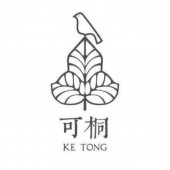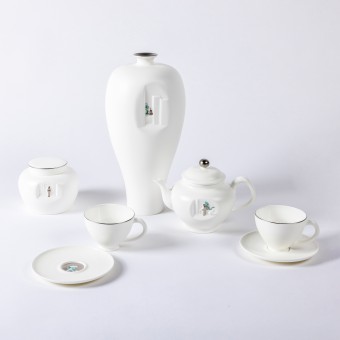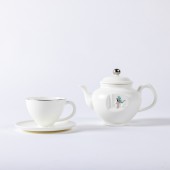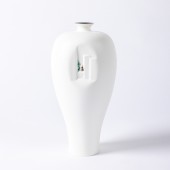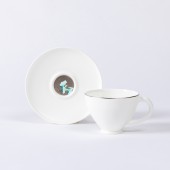DESIGN NAME:
Elsewhere
PRIMARY FUNCTION:
Tableware
INSPIRATION:
Elsewhere is a fable, a space within a space, a solid nothingness, a reality that is cut off. It is a faithful reproduction of classic Chinese porcelain shapes, embodying the Confucian aesthetics of dignity, fullness, steadiness, and calmness. But Elsewhere also breaks perfection - a part of perfection is cut off, revealing the content of the entity, which is: a person looking away from this world, towards a hard pot or the emptiness in it. The cut-off part is the soul out of the body.
UNIQUE PROPERTIES / PROJECT DESCRIPTION:
Elsewhere is a porcelain tableware set that blends tea and floral art. It draws from the Chinese aesthetics and philosophy, but also subverts them with a daring design. The pieces have a white finish and an indented design with small cut-outs showing an inner layer. The cut-outs contrast the solid and the void, the perfect and the imperfect, the real and the imaginary. They lure the user to discover the hidden beauty and meaning of the objects, and to flee from the dull reality to a different world. Elsewhere is not just a functional and elegant tableware set, but also a poetic and symbolic expression of the human condition.
OPERATION / FLOW / INTERACTION:
This object is a set of porcelain tableware that can be operated by pouring hot water into the teapot and the vase, and adding tea leaves and flowers. The object transforms by creating a visual and aromatic contrast between the tea and the floral art, and by revealing the inner layer of the pieces through the small cut-outs. The interaction happens by inviting the user to appreciate the beauty and meaning of the objects, and to enjoy the tea and the floral art. The key frames are the moments when the user pours the water, adds the tea leaves and the flowers, and sees the inner layer of the pieces. This object deals a better result by adding a sense of ritual and elegance to the normal functionality of the tableware, and by making the tea and the floral art more decorative. It performs better by expressing the theme of elsewhere, a space within a space, a solid nothingness, a reality that is cut off.
PROJECT DURATION AND LOCATION:
The project started in May 2015 in Nanjing and finished in March 2016 in Nanjing.
|
PRODUCTION / REALIZATION TECHNOLOGY:
This design is made of bone china using the slip casting technique. It went through four firings: the first one was a high-temperature sintering, the second one was a medium-temperature glazing, the third one was a low-temperature decalcomania, and the fourth one was a low-temperature silver plating. Unlike ordinary bone china glazes, the design chooses to use a non-glossy white glaze with the intention of displaying a kind of ivory texture, and an indented design with small cut-outs revealing an inner layer. The cut-outs contrast the solid and the void, the perfect and the imperfect, the real and the imaginary. Wish to express the theme of elsewhere, a space within a space, a solid nothingness, a reality that is cut off. It drew inspiration from the Chinese traditional aesthetics and philosophy, but also challenged them with a bold and innovative design.
SPECIFICATIONS / TECHNICAL PROPERTIES:
vase:150 mm x 150 mm x 250 mm; teapot: 170mm x 120 mm x 130 mm; tea container: 110 mm x 100 mm x 110 mm; cup: 120 mm x 70 mm x 60 mm; cup plate: 130 mm x 130 mm x 15 mm.
TAGS:
Chinese Tea Ceremony, Ikebana, Bone china, Aesthetics in life, Ceramic design
RESEARCH ABSTRACT:
Elsewhere is a design research to create a porcelain tableware set that combines tea and floral art, drawing from and subverting the Chinese aesthetics and philosophy. I used a mixed-methods approach with 40 participants from different cultural backgrounds. The results showed that my design was appreciated by both groups, as it enhanced their tea and floral art experience, and created a sense of ritual and elegance. It offers a new way of enjoying tea and floral art.
CHALLENGE:
The hardest part of this design were
1. To create a design that matched the Chinese traditional aesthetics and philosophy, but also challenged them.
2. To do in-depth user research to understand the needs, preferences, and experiences of tea and floral art lovers from different cultural backgrounds.
3. To use materials and techniques that suited my design concept and theme.
4. To balance functionality and aesthetics, as well as tradition and innovation.
ADDED DATE:
2024-01-18 08:35:52
TEAM MEMBERS (1) :
IMAGE CREDITS:
Yuhua Li, 2023.
|
